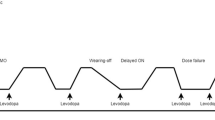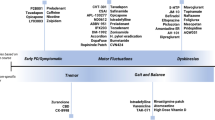Abstract
Dopaminergic treatment of Parkinson’s disease (PD) leads to significant improvement in Parkinsonian features; however, the treatment response is hampered by the appearance of motor complications, including dyskinesias and motor fluctuations. These motor complications have a significant negative impact on quality-of-life. Therapeutic strategies using different types and timing of dopaminergic therapy may influence the emergence of motor complications. While sustained release preparations of levodopa have not shown benefit over immediate release preparations, the early combination of a dopamine agonist with levodopa appears to reduce the onset of motor fluctuations. An even larger body of evidence has found that initiating treatment with a dopamine receptor agonist (as compared to immediate release levodopa) is associated with a reduction in motor fluctuations, particularly dyskinesias. These data have led to evidence-based medicine evaluations indicting that the use of dopamine agonists is efficacious and clinically useful for the prevention of motor complications.
Similar content being viewed by others
References
Allain H, Destee A, Petit H, et al. (2000) Five-year follow-up of early lisuride and levodopa monotherapy in de novo Parkinson’s disease. The French Lisuride Study Group. Eur Neurol 44:22–30
Chapuis S, Ouchchane L, Metz O, Gerbaud L, Durif F (2005) Impact of motor complications of Parkinson’s disease on the quality of life. Mov Disord 20:224–230
Constantinescu R, Romer M, McDermott MP, Kamp C, Kieburtz K, CALMPD Investigators of the Parkinson Study Group (2007) Impact of pramipexole on the onset of levodopa-related dyskinesias. Mov Disord online in Wiley InterScience (www.interscience.wiley.com). DOI:10.1002/mds.21292
Dupont E, Andersen A, Boas J, et al. (1996) Sustained-release Madopar HBS compared with standard Madopar in the long-term treatment of de novo parkinsonian patients. Acta Neurol Scand 93:14–20
Efficacy and safety of carbiodopa/levodopa/entacapone in patients with Parkinson’s disease requiring initiation of levodopa therapy. Clinical Trials. Government Identifier NCT00099268
Giménez-Roldán S, Tolosa E, Burguera JA, Chacón J, Liano, Forcadell F (1997) Early combination of bromocriptine and levodopa in Parkinson’s disease: a prospective randomized study of two parallel groups over a total follow-up period of 44 months including an initial 8-month double-blind stage. Clin Neuropharm 20:67–76
Goetz CG, Poewe W, Rascol O, Sampaio C (2005) Evidence-based medical review update: pharmacological and surgical treatments of Parkinson’s disease: 2001 to 2004. Mov Disord 20:523–539
Koller WC, Hutton JT, Tolosa E, Capilldeo R, and the Carbidopa/Levodopa Study Group (1999) Immediate-release and controlled-release carbidopa/levodopa in PD. A 5-year randomized multicenter study. Neurology 53:1012–1019
Nakanishi T, Iwata M, Goto I, et al. (1992) Nation-wide collaborative study on the long-term effects of bromocriptine in the treatment of parkinsonian patients. Final report. Eur Neurol 32(Suppl 1):9–22
Oertel WH, Wolters E, Sampaio C, et al. (2006) Pergolide versus levodopa monotherapy in early Parkinson’s disease patients: the PELMOPET study. Mov Disord 21:343–353
Parkinson Study Group (2000) Pramipexole vs. levodopa as initial treatment for Parkinson disease. A randomized controlled trial. JAMA 284:1931–1938
Przuntek H, Welzel D, Gerlach M, et al. (1996) Early institution of bromocriptine in Parkinson’s disease inhibits the emergence of levodopa-associated motor side effects. Long-term results of the PRADO study. J Neural Transm 103:699–715
Rascol O, Brooks DJ, Korczyn AD, et al. (2000) A five-year study of the incidence of dyskinesias in patients with early Parkinson’s disease who were treated with ropinirole or levodopa. N Engl J Med 342:1484–1491
Rinne UK (1989) Lisuride, a dopamine agonist in the treatment of early Parkinson’s disease. Neurology 39:336–339
Rinne UK, Bracco F, Chouza C, et al. (1988) Early treatment of Parkinson’s disease with cabergoline delays on the onset of motor complications. Results of a double-blind levodopa controlled trial. Drugs 55(Suppl):23–29
Author information
Authors and Affiliations
Corresponding author
Rights and permissions
About this article
Cite this article
Kieburtz, K. Therapeutic strategies to prevent motor complications in Parkinson’s disease. J Neurol 255 (Suppl 4), 42–45 (2008). https://doi.org/10.1007/s00415-008-4007-4
Published:
Issue Date:
DOI: https://doi.org/10.1007/s00415-008-4007-4




